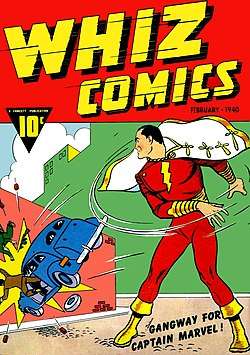Whiz Comics
Whiz Comics was a monthly ongoing comic book anthology series, published by Fawcett Comics from 1940–1953, best known for introducing Captain Marvel.[1]
| Whiz Comics | |
|---|---|
 Whiz Comics #2 (February 1940), the first appearance of Captain Marvel. Cover art by C. C. Beck. | |
| Publication information | |
| Publisher | Fawcett Comics |
| Schedule | Monthly |
| Format | Anthology |
| Genre | Superhero |
| Publication date | Feb. 1940 – June 1953 |
| No. of issues | 155 |
| Main character(s) | Captain Marvel |
Publication history
The first issue published of Whiz Comics was issue #2, published with a cover-date of Feb. 1940. Fawcett created two black-and-white ashcan #1 issues to solicit advertisers and to secure the copyrights to the material. The two copies were identical but carried different titles: Flash Comics and Thrill Comics; the Captain Marvel character was called "Captain Thunder" in a near-identical story. When Fawcett went to press with the magazine, the first issue was retitled as Whiz Comics, a name inspired by the company's bawdy humor magazine, Captain Billy's Whiz Bang.[2] Further complicating matters, when they got to issue #3, Fawcett, through either mistake or intent, used the number twice. Thus, if viewed from the perspective of the second #3 (and, therefore, all the issues that followed it), Whiz #2 unofficially became Whiz #1.
The cover art for the first issue showed Captain Marvel throwing a vehicle at a wall, and was inspired by the cover of Action Comics #1, which shows Superman lifting a car. The first issue was written by Bill Parker, who also wrote several other issues before Whiz became popular and other writers were hired.
Recurring features
Whiz contained the following features depicting adventures of various superhero characters:
- Captain Marvel
- Ibis the Invincible
- Spy Smasher
- Golden Arrow
- Dan Dare
- Lance O'Casey
- Scoop Smith
References
Notes
- Benton, Mike (1992). Superhero Comics of the Golden Age: The Illustrated History. Dallas: Taylor Publishing Company. p. 191. ISBN 0-87833-808-X. Retrieved 1 April 2020.
- Overstreet Comic Book Price Guide (Gemstone Publishing, 2007), pp 592–593.
Sources consulted
- Whiz Comics at the Grand Comics Database
- Whiz Comics at the Comic Book DB (archived from the original)
- Will Eisner's "Shop Talk" book.
| ← The characters Johnny Thunder and the Thunderbolt were debuted by John Whentworth and Stan Aschmeier. See Johnny Thunder and Thunderbolt (DC Comics) for more info and the previous timeline. | Timeline of DC Comics (1940s) February 1940 |
The characters Captain Marvel / Shazam!, the Wizard Shazam, the Seven Deadly Enemies of Man and Doctor Sivana were debuted by Bill Parker and C.C. Beck. See Captain Marvel (DC Comics), Shazam (wizard), Seven Deadly Enemies of Man and Doctor Sivana for more info and next timeline. → |